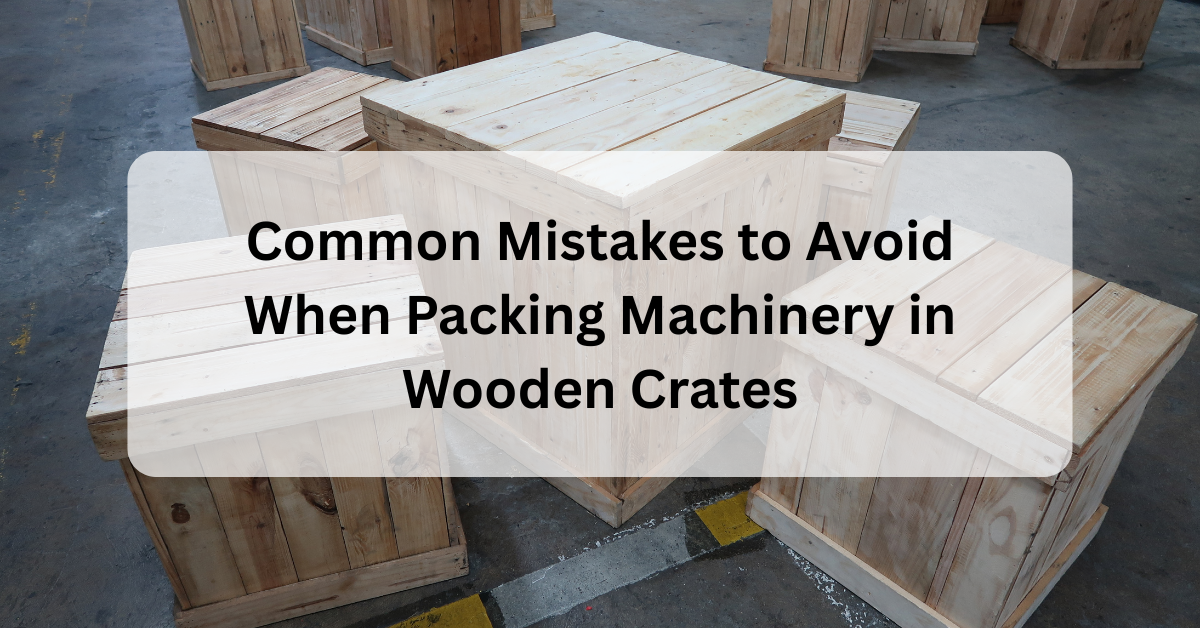Shipping heavy machinery overseas is never a small task—it’s high stakes, high cost, and one mistake can set you back thousands. That’s why wooden crates have become the go-to choice for businesses: they’re sturdy, compliant with international standards, and built to withstand the rough journey from warehouse to destination. Yet, despite their reliability, many companies still pack their machinery the wrong way—turning a secure shipment into an expensive mistake.
In this article, we’ll break down the common mistakes companies should avoid when packing machinery in wooden crates and share how Kai Beng’s expertise ensures your machinery reaches its destination safely.
Mistake #1: Choosing the Wrong Type of Wooden Crates
Not all wooden crates are created equal. Machinery often requires custom wooden crates designed to fit specific dimensions, weight, and fragility. A generic, off-the-shelf crate may not provide the structural integrity needed to protect against shocks, vibrations, or stacking pressure.
👉 Solution: Work with experienced crate manufacturers like Kai Beng, who design custom wooden crates tailored to your equipment’s needs. This ensures proper weight distribution and long-term durability throughout the shipping process.
Mistake #2: Ignoring ISPM 15 Compliance
One of the most common oversights is forgetting to comply with ISPM 15 regulations, which require wooden packaging to be heat-treated or fumigated before international shipping. Non-compliance can result in cargo being quarantined, rejected, or destroyed at the border.
👉 Solution: Always use ISPM 15-certified wooden crates. At Kai Beng, every wooden crate meets global phytosanitary standards, reducing the risk of shipment delays and ensuring smooth customs clearance. For more details on ISPM 15, you can refer to the official International Plant Protection Convention website.
Mistake #3: Poor Internal Cushioning and Securing
Even the strongest wooden crates cannot protect machinery if the interior is poorly packed. Loose or inadequate cushioning materials may lead to movement inside the crate, causing scratches, dents, or even severe mechanical damage.
👉 Solution: Use high-quality padding, blocking, and bracing techniques. Kai Beng’s team carefully evaluates each piece of machinery to determine the right combination of internal supports—whether foam, shock absorbers, or vibration-dampening materials—ensuring zero movement during transit.
Mistake #4: Overlooking Weight Capacity
Heavy machinery often exceeds the load-bearing limits of standard crates. Using a crate that is too weak can cause breakage, collapse, or injury during handling and loading.
👉 Solution: Always confirm the weight capacity of your wooden crates before packing machinery. Kai Beng engineers every crate to handle the exact load specifications, ensuring that the base and sides provide maximum support.
Mistake #5: Neglecting Moisture Protection
Machinery is highly vulnerable to moisture damage during international shipping, especially on long sea voyages. Wooden crates alone may not be enough to protect against condensation, humidity, or saltwater exposure.
👉 Solution: Incorporate moisture barriers such as vacuum-sealed wrapping, VCI (Volatile Corrosion Inhibitors) film, or desiccants inside the crate. Kai Beng offers complete export packing solutions with anti-rust and anti-moisture protection to safeguard sensitive equipment.
Mistake #6: Failing to Label Crates Correctly
Improper or missing labeling can cause delays in logistics handling and increase the risk of mishandling. For example, a crate without “Fragile,” “This Side Up,” or weight markings may be stacked incorrectly or lifted with the wrong equipment.
👉 Solution: Always ensure wooden crates are properly marked with international shipping symbols, handling instructions, and detailed shipping labels. At Kai Beng, every crate is professionally labeled to comply with global logistics standards.
Mistake #7: Not Engaging Professional Packing Services
One of the biggest mistakes businesses make is treating machinery packing as a DIY task. Unlike general cargo, machinery requires expertise in load balancing, structural engineering, and global compliance.
👉 Solution: Rely on professional packing companies like Kai Beng, with over 30 years of experience in custom crating and machinery export. Our team of experts ensures every detail—from crate construction to cushioning and labeling—is handled with precision.
Why Choose Kai Beng for Wooden Crates in Singapore?
For businesses in Singapore, choosing the right partner for wooden crates can make the difference between a smooth export process and costly shipping delays. Kai Beng has built a strong reputation as a trusted provider of custom wooden crates, ISPM 15-certified packaging, and machine-moving solutions.
With our deep expertise, compliance-driven approach, and tailored solutions, we help businesses avoid the most common mistakes in machinery packing. Whether you’re shipping locally or internationally, Kai Beng ensures your equipment arrives safe, secure, and on time.
Conclusion
Investing in high-quality wooden crates is not just about packaging—it’s about protecting your machinery, ensuring compliance, and avoiding unnecessary costs. By avoiding these common mistakes and working with a trusted partner like Kai Beng, your business can enjoy peace of mind when exporting heavy equipment.
